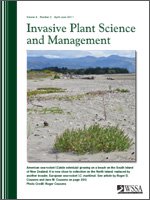A total of 24 pre-and posttreatment plant frequency data sets were analyzed from 15 Wisconsin lakes treated with granular 2,4-D BEE herbicide for the control of Eurasian watermilfoil (Myriophyllum spicatum). Six data sets from four untreated control lakes were analyzed for comparison. The data sets included the results of line-transect aquatic plant surveys and point-intercept aquatic plant surveys. The results from these two survey methods were analyzed separately. Analysis of pre-and posttreatment changes in frequency of occurence for 46 species of aquatic plants indicated Eurasian watermilfoil was the only species to show significant declines in all the surveys. At application rates of 112 kg ha−1, Eurasian watermilfoil declined an average 65.9% among the line-transect surveys; and 58.0% among the point-intercept surveys. At application rates of 168 kg ha−1, Eurasian watermilfoil declined by 94.4% and 76.5% among line-transect and point-intercept surveys, respectively. Among the control lakes, Eurasian watermilfoil increased an average of 77% in year 1 and 24% in year 2. Northern watermilfoil (Myriophyllum sibiricum), a closely related native plant, underwent declines in frequency at the higher 2,4-D application rate (20.0%) but showed an increase (88.9%) at the lower rate among the line-transect surveys. Northern watermilfoil exhibited declines at both rates among the point-intercept surveys (48 and 50%, respectively); however, the plant also exhibited declines in the control lakes in year 2. Most other native aquatic plant species were unaffected or showed increases following treatment with 2,4-D BEE. The high degree of selectivity to Eurasian watermilfoil found in this survey of operational treatments with 2,4-D BEE suggests that this herbicide is an important tool for restoring plant communities that have been degraded by Eurasian watermilfoil.
Nomenclature: Granular 2,4-D BEE, 2,4-dichlorophenoxyacetic acid-butoxyethyl ester; Eurasian watermilfoil, Myriophyllum spicatum L.; northern watermilfoil, Myriophyllum sibiricum Kom





